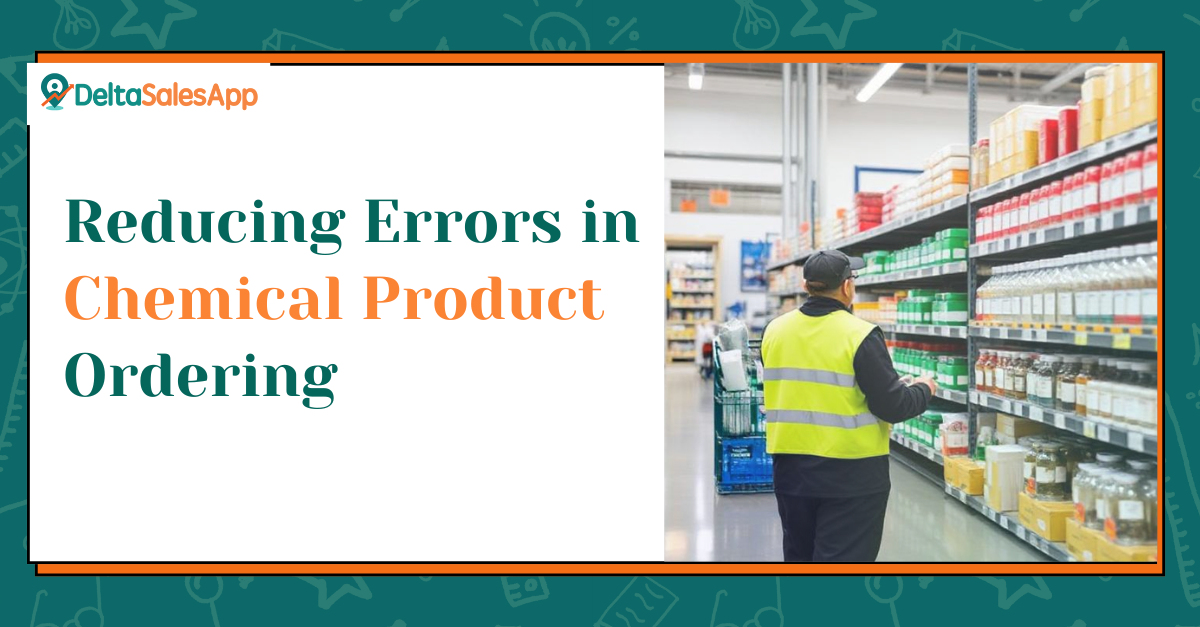Reducing Errors In Chemical Product Ordering

Chemical product ordering is a crucial process in many industries, including pharmaceuticals, manufacturing, and agriculture. However, errors in this process can lead to significant consequences, such as production delays, financial losses, and safety hazards.
In this blog, we will explore the common causes of errors in chemical product ordering and provide practical solutions to reduce these errors, ensuring a smoother and more efficient ordering process.
Common Causes of Errors in Chemical Product Ordering
Before we dive into strategies for reducing errors, it's important to understand where these mistakes typically occur. Identifying the root causes can help in implementing targeted solutions.
1. Manual Data Entry Errors
One of the most common causes of errors in chemical product ordering is manual data entry. When staff members input information about products, quantities, and specifications by hand, there's a higher chance of making mistakes. These mistakes can lead to incorrect orders, wrong product shipments, or discrepancies in inventory records.
2. Lack of Standardized Processes
In many organizations, the process for ordering chemical products is not standardized. Different teams may follow different procedures, making it harder to track orders and ensure consistency. Without clear guidelines, there’s room for human error, which can lead to incorrect orders.
3. Poor Communication
Communication breakdowns between sales teams, procurement, and suppliers can result in errors. For example, sales teams may miscommunicate customer requirements to procurement teams, or procurement may fail to verify product specifications with suppliers, leading to the wrong products being ordered.
4. Unclear Product Specifications
Chemical products often come with complex specifications, such as chemical composition, grade, packaging, and safety requirements. If these details are not clearly communicated or understood, it can lead to ordering errors. This is particularly true when dealing with bulk orders or custom formulations, where even a minor mistake can have significant consequences.
5. Lack of Real-time Inventory Data
When inventory levels are not tracked in real-time, companies risk ordering products they already have in stock or over-ordering products that are not required. This can result in wasted resources, stockouts, or excess inventory, leading to inefficiency and financial loss.
6. Inaccurate or Outdated Supplier Information
Suppliers may change product availability, specifications, or prices, and it’s essential for the purchasing team to be up-to-date with this information. If a company relies on outdated supplier data, they may order incorrect products or fail to obtain the right quantities at the correct prices.
Solutions for Reducing Errors in Chemical Product Ordering
Now that we’ve identified the common causes, let’s explore actionable solutions that can help reduce errors in chemical product ordering.
1. Implementing Automated Ordering Systems
One of the most effective ways to reduce errors is by adopting automated ordering systems. These systems can eliminate manual data entry by allowing users to place orders using pre-populated data from past transactions, inventory levels, and product specifications. Automated systems can also flag discrepancies or incomplete orders, ensuring that all required information is included before submission.
2. Standardizing Ordering Procedures
Creating standardized procedures for ordering chemical products ensures that every team follows the same process, reducing the chance of errors. Standard operating procedures (SOPs) should outline the steps involved in placing orders, verifying product specifications, and confirming quantities. Training all employees involved in the ordering process on these standards is crucial to minimizing errors.
3. Clear Communication Channels
Establishing clear communication channels between the sales, procurement, and supplier teams is essential for reducing errors. Regular meetings, digital collaboration tools, and clear documentation can help ensure that everyone involved in the process is on the same page. Communication tools like emails, project management software, and instant messaging platforms can bridge gaps in real-time communication.
4. Using Advanced Inventory Management Tools
Real-time inventory management tools can help prevent over-ordering or stockouts. These tools allow companies to track product levels and automatically reorder items when stock reaches a predefined threshold. By integrating inventory management with the ordering system, businesses can ensure that they only order products when necessary and reduce the risk of errors in inventory data.
5. Regularly Updating Supplier Information
Maintaining accurate and up-to-date supplier information is vital. This includes regularly reviewing product catalogs, prices, and availability with suppliers. Implementing a supplier management system that integrates with your ordering platform can streamline this process and ensure that the latest supplier information is always available.
6. Incorporating Product Verification Checks
Incorporating checks at multiple stages of the ordering process can help catch errors before they become problems. For instance, after an order is placed, a verification step can be added where the team cross-checks the product specifications, quantities, and shipping details. Additionally, utilizing barcode scanning or product identifiers can help ensure that the correct items are selected.
7. Training and Continuous Improvement
Ongoing training is essential to reducing errors. Regularly train employees involved in the ordering process on new procedures, technologies, and product knowledge. Additionally, encourage a culture of continuous improvement, where employees can identify and suggest process enhancements to reduce errors.
How to Streamline the Approval Process for Chemical Orders
A streamlined approval process is vital to prevent delays and errors during chemical product ordering. Here are some strategies to simplify and enhance the approval workflow:
Define Approval Stages: Clearly define each step of the approval process, including who needs to review and approve the orders at different stages.
Automated Approval Systems: Implement automated workflows that route orders to the appropriate personnel for approval, ensuring quicker and more consistent approvals.
Use Digital Approval Tools: Utilize digital platforms for approval, where teams can review, comment, and approve orders in real-time, reducing paperwork and delays.
Set Clear Thresholds: Establish clear approval thresholds based on order value or complexity, allowing simpler orders to go through quickly while more complicated ones undergo thorough reviews.
By optimizing the approval process, companies can reduce bottlenecks, ensure faster turnaround times, and minimize the chance of errors.
Preventing Over-Stocking and Under-Stocking: Striking the Right Balance
Striking the right balance between overstocking and understocking is a critical aspect of chemical product ordering. Both extremes can have detrimental effects on business operations, so it’s essential to manage inventory levels effectively.
Demand Forecasting: Implement demand forecasting tools that analyze historical data and predict future needs. This helps to avoid ordering too much or too little.
Safety Stock: Maintain a buffer or safety stock to avoid stockouts during unforeseen surges in demand, but avoid overstocking that ties up valuable resources.
Real-Time Inventory Monitoring: Continuously monitor inventory levels in real-time to adjust orders dynamically based on current stock levels and demand trends.
Reorder Points: Set reorder points based on critical stock levels. This helps ensure that products are reordered before reaching low levels, preventing both overstock and understock situations.
Balancing stock levels can significantly reduce errors, improve operational efficiency, and prevent unnecessary costs associated with excess or insufficient inventory.
The Benefits of Reducing Errors in Chemical Product Ordering
Reducing errors in the ordering process not only saves time and resources but also enhances overall business efficiency. Here are a few key benefits:
Cost Savings: Fewer errors mean fewer returns, replacements, and reorders, leading to reduced operational costs.
Improved Customer Satisfaction: Accurate orders ensure that customers receive the correct products on time, improving customer trust and satisfaction.
Increased Efficiency: Streamlining the ordering process with automation and standardized procedures allows employees to focus on higher-value tasks, increasing productivity.
Enhanced Safety and Compliance: By ordering the correct chemicals with the right specifications, businesses can avoid safety hazards and ensure compliance with regulatory requirements.
Conclusion
Errors in chemical product ordering can have significant consequences for any organization. However, by implementing automated systems, standardizing processes, and ensuring clear communication, businesses can drastically reduce the likelihood of these errors. With the right tools and practices in place, companies can streamline their ordering process, improve efficiency, and ensure the safety and satisfaction of their customers.
FAQ
1. What are the most common errors in chemical product ordering?
The most common errors include manual data entry mistakes, poor communication between teams, lack of standardized procedures, unclear product specifications, and outdated supplier information.
2. How can automation reduce errors in chemical product ordering?
Automation eliminates manual data entry by using pre-populated information, reducing the chances of human error. It also allows for real-time tracking and verification of orders, ensuring accuracy.
3. How can I ensure that suppliers' information is accurate?
Regularly review and update supplier catalogs, prices, and product availability. Implementing a supplier management system can help you track this information more effectively.
4. What role does employee training play in reducing errors?
Employee training ensures that everyone involved in the ordering process understands the correct procedures, product specifications, and the use of automation tools. Ongoing training helps employees stay up-to-date with best practices and reduces the likelihood of mistakes.









